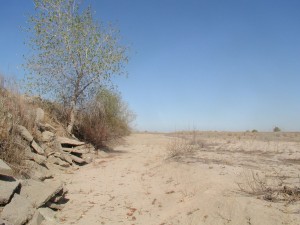
History? Not around here…
“Like most environmentalists, they want it all,” said Oakdale Irrigation District (OID) General Manager Steve Knell recently when discussing water rights along the Stanislaus River.
Though absurd on the face of it, Knell’s claim represents a widespread belief throughout the San Joaquin Valley, where environmental illiteracy and historical amnesia have enabled private appropriation of public resources since the days of the gold rush. The simple fact is that “wanting it all” is impossible in the San Joaquin Valley because “it” is almost all gone.
Consider Tulare Lake in the southern part of the Valley. It was once the largest freshwater lake west of the Mississippi. Tulare Lake was completely drained by 1899. It wasn’t partly drained, largely drained, or even almost all drained. It was drained entirely, not by environmentalists but by Big Ag, especially corporate giants like Boswell and Salyer.
Beginning with Charles Lux and Henry Miller in the late nineteenth century, industrial agriculture has dominated water use in the San Joaquin Valley, frequently to the point of total depletion. In fact, according to the U.S. Geological Survey, by 1910, “nearly all the available surface water in the San Joaquin had been diverted,” almost entirely for agriculture.
Today, those who claim environmental needs for water are unreasonable also argue that without surface water for agriculture, farmers will be forced to pump groundwater. The truth is, they’ve been pumping all along; industrial agriculture depleted sustainable groundwater resources in the southern San Joaquin Valley long ago.
Almost immediately after the completion of the Delta-Mendota Canal in 1951, subsidence from overdrafting groundwater was seen as a threat to the structural integrity of the canal. Today, subsidence as much as two feet per year in some regions is causing cracks in the canal.
Groundwater has always been a major source for water in the San Joaquin Valley, not just for agriculture, but for urban uses as well. Modesto is one of the very few cities in the Valley with adequate supplies of surface water for its urban users. Fresno, the largest city in the Central Valley, depends on groundwater for 85% of its summer use and 70% of its winter water usage.
Apologists for corporate agriculture also claim environmentalists want to waste water on fish, but only after decades of legislation was there any water at all for salmon runs in the San Joaquin River. In April 2014, Chinook Salmon were returned after an absence of sixty years.
The San Joaquin River is California’s second largest; the salmon runs historically numbered in the hundreds of thousands. Salmon weren’t partly gone, largely gone, or even almost all gone; the salmon runs were entirely gone and so was almost all the water. Period.
It wasn’t environmentalists who “took it all,” and it wasn’t even urban users. The water was taken (the euphemism is “diverted”) by agricultural users who calculated that unsustainable agriculture was nevertheless profitable agriculture, especially when it could exploit public resources.
When corporate farmers in the southern part of the Valley ran out of groundwater and had depleted the rivers in their own region, they began promoting water sales from the northern part of the state (euphemistically called “transfers”). One of the most enthusiastic promoters of water sales is none other than Steve Knell, who has admitted the OID business plan depends on selling water outside the district. He’s presided over the sale of 382,408 acre feet of water over the last decade.
Most of OID’s water sales have gone south to Westlands Water District. Despite having very junior water rights, Westlands is the largest water district in the United States. Especially since so many of its members have planted permanent crops, it’s dependent on northern water sources for survival.
It’s not environmentalists who want it all, it’s Big Ag. And in those places where it has already taken it all, it wants more, which means it must buy water from places like the Oakdale Irrigation District. And as long as he can blame environmentalists for the region’s water woes, OID’s Steve Knell is happy to sell.
Next: Fact? Fiction? What’s the diff?
